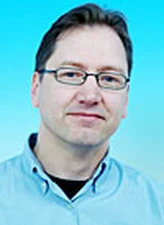Jaap S. Sinninghe Damsté

The 2007 Vladimir Ivanovich Vernadsky Medal is awarded to Jaap S. Sinninghe Damsté for his innovative use of biomarkers to elucidate interactions between the Biosphere and Geosphere across major ecosystems and timescales.
Professor Jaap Smede Sinnighe Damsté was born on January 1, 1959 in Baarn, The Netherlands. He studied analytical environmental chemistry at the Technical University of Delft (1984, Cum Laude) and obtained a Ph. D. in organic geochemistry from the same university (1988, Cum Laude). In 1993 he moved to the Royal Netherlands Institute for Sea Research, where he now heads the Marine Biogeochemistry and Toxicology Department. He is professor of molecular paleontology at the Utrecht University (since 2003), member of the Royal Netherlands Academy of Arts and Sciences (since 2005) and a recipient of the Treibs Award from the Geochemical Society.
Vladimir Vernadsky has advanced the key concepts of Biosphere and Geosphere and identified the need to elucidate interactions between these domains. These interactions occur in all major earth systems and involve archaea, bacteria and eukaryotes. Jaap Sinninghe Damsté has made major contributions to our understanding of all these domains (both in term of kingdoms of life or in terms of major ecosystems). Moreover, his excellent and lasting contributions concern not only modern ecosystems on land or in the ocean, but he has also elucidated past ecosystems using innovative approaches.
His Ph.D. work on organic sulfur was truly ground-breaking and resulted in a revision of global geochemical carbon and sulfur cycling. Sinninghe Damsté and colleagues have developed numerous paleoceanographic proxies and molecular indices that have opened new avenues for tracing (past) ecosystem functioning and linking microbial identity with biogeochemical activity. Examples include ladderane lipids for bacteria involved in Anammox and isorenieretene, a molecular proxy for photic zone anoxia. His study of rise of the rhizosolenid diatoms via the occurrence of highly branched isoprenoid alkenes in sediments provided not only unprecedented detail on evolution of diatoms, but also an independent calibration of the molecular clock. Recently, his research group has discovered that archaea are widely distributed in the ocean and that some members are chemoautotrophs fixing carbon dioxide via oxidation of ammonium. Moreover, they have used archaeal membrane lipids to develop a novel paleothermometer (TEX86), and its application has already generated a number of new, perplexing insights.
